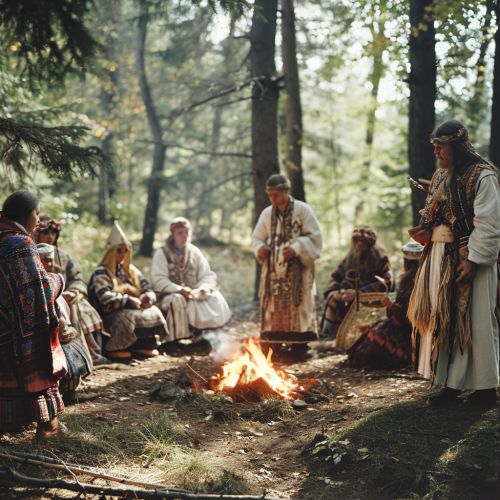Baltic mythology
Origins and Development
Baltic mythology refers to the body of mythical narratives and religious beliefs held by the Baltic peoples, including the Lithuanians, Latvians, and Old Prussians. These peoples, who resided in the region surrounding the Baltic Sea, developed a rich and complex mythology that was deeply intertwined with their social structure, cultural practices, and understanding of the natural world.


The origins of Baltic mythology can be traced back to the Proto-Indo-European period, with many elements of the mythology showing similarities to other Indo-European mythologies such as Norse, Slavic, and Greek. The Baltic peoples were among the last in Europe to be Christianized, allowing for a relatively high degree of preservation of their pre-Christian religious traditions and myths.
Deities and Supernatural Beings
At the heart of Baltic mythology are the many deities and supernatural beings that populate its narratives. These include a pantheon of gods and goddesses, as well as a host of spirits, demons, and other entities.
The chief god in the Baltic pantheon is Dievas (in Lithuanian) or Dievs (in Latvian), a sky god similar to the Indo-European sky father, Dyeus. Dievas is associated with the heavens, order, and justice, and is often depicted as a powerful, bearded man. Other important deities include Perkūnas, the god of thunder and lightning, and Laima, the goddess of fate and childbirth.
The Baltic mythological world is also populated by a variety of spirits, each associated with specific natural features or aspects of life. These include the laumes, female spirits associated with forests and fields, and the kaukas, house spirits believed to protect the home and its inhabitants.
Cosmology and Mythic Narratives
Baltic cosmology is characterized by a tripartite division of the world into the heavens, the earth, and the underworld. The heavens are the realm of the gods, while the earth is the domain of humans and other living creatures. The underworld, often associated with bodies of water, is the realm of the dead and various supernatural beings.
Many of the mythic narratives in Baltic mythology revolve around the interactions between these three realms. For example, the thunder god Perkūnas is often depicted in myths as battling serpents or dragons, symbols of chaos and disorder, in order to maintain the cosmic order.
Rituals and Practices
Rituals and practices in Baltic mythology were closely tied to the natural world and the agricultural cycle. Key events such as sowing, harvesting, and the changing of the seasons were marked by communal rituals and celebrations.
One of the most important rituals was the veneration of the dead, which was believed to ensure the wellbeing of the community and the fertility of the land. This involved offerings of food and drink, and the maintenance of sacred groves and burial mounds.
Influence and Legacy
Despite the Christianization of the Baltic peoples in the Middle Ages, elements of Baltic mythology have survived and continue to influence contemporary Baltic culture. Many traditional customs, folk songs, and stories that originated in the pre-Christian era are still practiced and told today.
In recent years, there has been a resurgence of interest in Baltic mythology, with a growing number of people seeking to reconnect with their ancestral traditions and beliefs. This has led to a revival of ancient rituals and practices, and a renewed appreciation for the rich mythological heritage of the Baltic peoples.
